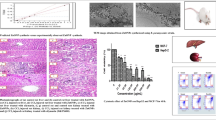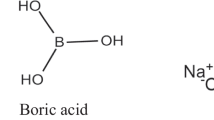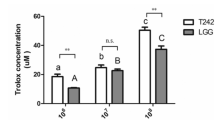Abstract
Boron has an important potential for facilitating biological activity and for use in pharmaceutical drug design. Boron glycine monoester (BGM) and boron glycine diester (BGD) compounds containing boron atoms were synthesized and investigated their cytotoxic, oxidative stress, and antimicrobial activities on the HepG2 cancer cell line. The cytotoxic activity of newly synthesized boron compounds on hepatocellular carcinoma was determined by the MTT method for 48 h. Antioxidant (CAT, GSH), lipid peroxidation (MDA), and enzyme activity (ACP, ALP) analyses were determined by spectrophotometric methods in HepG2 cells. Antimicrobial activity was determined by the disk diffusion method. After 48 h of BGM and BGD application to HepG2 cells, we found the IC50 values as 9.9 mM and 24 mM, respectively. While CAT and ACP enzyme activities decreased in all groups compared to the control, ALP enzyme activity did not change in the BGM group but increased in the BGD group. It was determined that the GSH level did not change in all groups, while the MDA level increased. It has been stated that these IC50 doses of BGM and BGD have antibacterial effects on Staphylococcus aureus ATCC 29213 and Escherichia coli ATCC 25922. Newly synthesized boron compounds, particularly BGM, with their cytotoxic, oxidative stress, and antimicrobial effects, could provide a new therapeutic approach for the treatment of hepatocellular carcinoma.








Similar content being viewed by others
Data Availability
Not applicable
References
Hashem B, El-Serag (2020) Epidemiology of hepatocellular carcinoma. In: Arias IM, Alter HJ, Boyer JL, Cohen DE, Shafritz DA, Thorgeirsson SS, Wolkoff AW (eds) The liver: biology and pathobiology, 6th edn. John Wiley & Sons Ltd. Published, pp 758–772
McGlynn KA, Petrick JL, London WT (2015) Global epidemiology of hepatocellular carcinoma: an emphasis on demographic and regional variability. Clin Liver Dis 19(2):223–238. https://doi.org/10.1016/j.cld.2015.01.001
Singal AG, El-Serag HB (2015) Hepatocellular carcinoma from epidemiology to prevention: translating knowledge into practice. Clin Gastroenterol Hepatol 13(12):2140–2151. https://doi.org/10.1016/j.cgh.2015.08.014
Zender L, Spector MS, Xue W, Flemming P, Cordon-Cardo C, Silke J, Fan ST, Luk JM, Wigler M, Hannon GJ, Mu D, Lucito R, Powers S, Lowe SW (2006) Identification and validation of oncogenes in liver cancer using an integrative oncogenomic approach. Cell 125:1253–1267. https://doi.org/10.1016/j.cell.2006.05.030
Bruix J and Sherman M; American Association for the Study of Liver Diseases (2011) Management of hepatocellular carcinoma: an update. Hepatology 53:1020–1022. https://doi.org/10.1002/hep.24199
Halliwell B (2006) Oxidative stress and neurodegeneration: where are we now? J Neurochem 97(6):1634–1658. https://doi.org/10.1111/j.1471-4159.2006.03907.x
Çiftçi N (2017) Oksidatif Stresin Kanserdeki Rolü: Antioksidanlar Kanser Progresyonunun Yakıtı Olabilir mi? Ahi Evran Tıp Dergisi 1:8–13
Schumacker PT (2015) Reactive oxygen species in cancer: a dance with the devil. Cancer Cell 27(2):156–157. https://doi.org/10.1016/j.ccell.2015.01.007
Scorei R (2012) Is boron a prebiotic element? A mini-review of the essentiality of boron for the appearance of life on earth. Orig Life Evol Biosph 42:3–17. https://doi.org/10.1007/s11084-012-9269-2
Murray FJ (1998) A comparative review of the pharmacokinetics of boric acid in rodents and humans. Biol Trace Elem Res 66:331–341. https://doi.org/10.1007/BF02783146
Nielsen FH (2008) Is boron nutritionally relevant? Nutr Rev 66:183–191. https://doi.org/10.1111/j.1753-4887.2008.00023.x
Singh NP, Danner DB, Tice RR, Brant L, Schneider EL (1990) DNA damage and repair with age in individual human lymphocytes. Mutat. Res 237:123–130. https://doi.org/10.1016/0921-8734(90)90018-m
Tombuloglu A, Copoglu H, Aydin-Son Y, Guray NT (2020) In vitro effects of boric acid on human liver hepatoma cell line (HepG2) at the half-maximal inhibitory concentration. J Trace Elem Med Bio 62:126573. https://doi.org/10.1016/j.jtemb.2020.126573
Wei Y, Yuan FJ, Zhou WB, Wu L, Chen L, Wang JJ, Zhang YS (2016) Borax-induced apoptosis in HepG2 cells involves p53, Bcl-2, and Bax. Genet Mol Res 21:15(2). https://doi.org/10.4238/gmr.15028300
Eijssen LMT, Jaillard M, Adriaens ME, Gaj S, de Groot PJ, Müller M, Evelo CT (2013) User-friendly solutions for microarray quality control and pre-processing on ArrayAnalysis.oRg. Nucleic Acids Res:W71-6. https://doi.org/10.1093/nar/gkt293
Dai M, Wang P, Boyd AD, Kostov G, Athey B, Jones EG, Bunney WE, Myers RM, Speed TP, Akil H, Watson SJ, Meng F (2005) Evolving gene/transcript definitions significantly alter the interpretation of GeneChip data. Nucleic Acids Res 10;33(20):e175. https://doi.org/10.1093/nar/gni179
Axtell JC, Saleh LM, Qian EA, Wixtrom AI, Spokoyny AM (2018) Synthesis and applications of perfunctionalized boron clusters. Inorg Chem 57:2333–2350. https://doi.org/10.1021/acs.inorgchem.7b02912
Hawthorne MF, Maderna A (1999) Applications of radiolabeled boron clusters to the diagnosis and treatment of cancer. Chem Rev 99:3421–3434. https://doi.org/10.1021/cr980442h
Qian EA, Wixtrom AI, Axtell JC, Saebi A, Jung D, Rehak P, Han Y, Moully EH, Mosallaei D, Chow S (2017) Atomically precise organomimetic cluster nanomolecules assembled via perfluoroaryl-thiol S N Ar chemistry. Nat Chem 9:333–340. https://doi.org/10.1038/nchem.2686
Hawthorne MF (1993) The role of chemistry in the development of boron neutron capture therapy of cancer. Angew Chem Int Ed Engl 32:950–984
Aydin HE, Koldemir Gündüz M, Kizmazoğlu C, Kandemir T, Arslantaş A (2020) Cytotoxic effect of boron application on glioblastoma cells. Turk Neurosurg:1–5. https://doi.org/10.5137/1019-5149.JTN.30316-20.1
da Silva FJ, Williams RJ (1991) The biological chemistry of the elements: the ınorganic chemistry of life. Oxford University Press Oxford, UK, pp 58–63
Murray FJ (1995) A human health risk of boron (boric acid and borax) in drinking water. Regulatory Toxicology and Pharmacology 22:221–230. https://doi.org/10.1006/rtph.1995.0004
Hunt CD (1998) Regulation of enzymatic activity: one possible role of dietary boron in higher animals and humans. Biology Trace Elem Res 66:205–225. https://doi.org/10.1007/BF02783139
Köse DA, Zumreoglu-Karan B, Hökelek T (2011) A comparative examination of mono- and bis-chelate salicylatoborate complexes and the crystal structure of layered magnesium bis-salicylatoborate. Inorganica Chimica Acta 375:236–241. https://doi.org/10.1016/j.ica.2011.05.012
Köse DA, Zümreoglu-Karan B (2012) Mixed ligand complexes of boric acid with organic biomolecules. Chemical Papers 66(1):54–60. https://doi.org/10.2478/s11696-011-0108-0
Köse DA (2008) Preparation and structure investigation of biopotent boron compounds with hydroxy-functionalized organic molecules. PhD Thesis, Hacettepe University, Science Institute, Ankara
Zumreoglu-Karan B, Kose DA (2015) Boric acid: a simple molecule of physiologic, therapeutic and prebiotic significance. Pure and Applied Chemistry 87(2):155–162. https://doi.org/10.1515/pac-2014-0909
Köse DA, Karan-Zümreoğlu B (2009) Complexation of boric acid with vitamin C. N J Chem 33:1874–1881. https://doi.org/10.1039/B902812A
Miggiano GA, Gagliardi L (2005) Diet, nutrition and bone health. Clin Ter 156(1-2):47–56. https://doi.org/10.4103/jmsr.jmsr4118
Frommer WB, von Wirén N (2002) Plant biology: ping-pong with boron. Nature. 420:282–283. https://doi.org/10.1038/420282a
Miwa K, Fujiwara T (2010) Boron transport in plants: co-ordinated regulation of transporters. Ann. Bot. 105:1103–1108. https://doi.org/10.1093/aob/mcq044
Park M, Li Q, Shcheynikov N, Zeng W, Muallem S (2004) NaBC1 is a ubiquitous electrogenic Na+-coupled borate transporter essential for cellular boron homeostasis and cell growth and proliferation. Mol. Cell. 16:331–341. https://doi.org/10.1016/j.molcel.2004.09.030
Park M, Li Q, Shcheynikov N, Muallem S, Zeng W (2005) Borate transport and cell growth and proliferation: not only in plants. Cell Cycle. 4:24–26. https://doi.org/10.4161/cc.4.1.1394
Zhang W, Ogando DG, Bonanno JA, Obukhov AG (2015) Human SLC4A11 is a novel NH3:H+ co-transporter. J. Biol. Chem. 290:16894–16905. https://doi.org/10.1074/jbc.M114.627455
Zangi R, Filella M (2012) Transport routes of metalloids into and out of the cell: a review of the current knowledge. Chem. Biol. Interact. 197:47–57. https://doi.org/10.1016/j.cbi.2012.02.001
Kao L, Azimov R, Shao XM, Frausto RF, Abuladze N, Newman D, Aldave AJ, Kurtz I (2016) Multifunctional ion transport properties of human SLC4A11: comparison of the SLC4A11-B and SLC4A11-C variants. Am. J. Physiol. - Cell Physiol. 311:C820–C830. https://doi.org/10.1152/ajpcell.00233.2016
Zhang W, Ogando DG, Kim ET, Choi MJ, Li H, Tenessen JM, Bonanno JA (2017) Conditionally immortal Slc4a11-/- mouse corneal endothelial cell line recapitulates disrupted glutaminolysis seen in Slc4a11-/- mouse model. Investig. Opthalmology Vis. Sci. 58:3723–3731. https://doi.org/10.1167/iovs.17-21781
Mukhopadhyay R, Bhattacharjee H, Rosen BP (2014) Aquaglyceroporins: generalized metalloid channels. Biochim Biophys Acta - Gen Subj 1840:1583–1591. https://doi.org/10.1016/j.bbagen.2013.11.021
Scorei IR (2013) Popa R (2013) Sugar-borate esters – potential chemical agents in prostate cancer chemoprevention. Anticancer Agents Med Chem 13:901–909
Donoiu I, Militaru C, Obleagă O, Hunter JM, Neamţu J, Biţă A, Scorei IR, Rogoveanu OC (2018) Effects of boron-containing compounds on cardiovascular disease risk factors - A review. J Trace Elem Med Biol 50:47–56. https://doi.org/10.1016/j.jtemb.2018.06.003
Hunter JM, Nemzer BV, Rangavajla N, Biţă A, Rogoveanu OC, Neamţu J, Scorei IR, Bejenaru LE, Rău G, Bejenaru C, Mogoşanu GD (2019) The fructoborates: part of a family of naturally occurring sugar-borate complexes-biochemistry, physiology, and impact on human health: a review. Biol Trace Elem Res 188(1):11–25. https://doi.org/10.1007/s12011-018-1550-4
Kose DA, Necefoglu H, Sahin O, Buyukgungor O (2011) Synthesis, spectral, thermal and structural study of monoaquabis (acetylsalicylato-κO)bis(nicotinamide κN) copper(II). Journal of Chemical Crystallography 41(2011):297–305. https://doi.org/10.1007/s10870-010-9876-6
Westerink WMA, Willem GEJ (2007) Schoonen Phase II enzyme levels in HepG2 cells and cryopreserved primary human hepatocytes and their induction in HepG2 cells. Toxicol In Vitro 21(8):1592–1602. https://doi.org/10.1016/j.tiv.2007.06.017
Köse DA, Karan Zümreoğlu B, Hökelek T, Şahin E (2010) Boric acid complexes with organic biomolecules: Mono-chelate complexes with salicylic and glucuronic acids. Inorganica Chimica Acta 363:4031–4037
Yerlikaya A, Okur E, Şeker S, Erin N (2010) Combined effects of the proteasome inhibitor bortezomib and Hsp70 inhibitors on the B16F10 melanoma cell line. Mol Med Rep 3:333–339. https://doi.org/10.3892/mmr00000262
Bradford MM (1976) A rapid and sensitive method for the quantitation of microgram quantities of protein utilizing the principle of protein-dye binding. Analytical Biochemistry 72:248–254. https://doi.org/10.1006/abio.1976.9999
Ledwozyw A, Michalak D, Stepien A, Kadziolka A (1986) The relationship between plasma triglycerides, cholesterol, total lipids and lipid peroxidation products during human atherosclerosis. Clin Chim Acta 155(3):275–283
Beutler E (1975) Glutathione in red cell metabolism: a manual of biochemical methods, 2nd edn. Grune and Stratton, NY, pp 112–114
Aebi H (1974) Catalase invitro. In: Bergmeyer HU (ed) 2 nd ed, FLMethods of enzymatic analysis, pp 121–126
Walter K, Schült C (1974) Acid and alkaline phosphatase in serum (two point method). In: Bergmeyer HU (ed) 2nd ed, FLMethods of Enzymatic Analysis, pp 856–886
CLSI-Clinical and Laboratory Standards Institute (2012) Performance standards for antimicrobial disk susceptibility tests; approved standard—Eleventh Edition. In: CLSI document M02-A11. PA. USA, Wayne
Boesekem J (1949) The use of boric acid for the determination of the configuration of carbohydrates. Adv Carbohydr Chem 4:189–210. https://doi.org/10.1016/S0096-5332(08)60049-1
Zittle C (1951) Reaction of borate with substances of biological interest. Adv Enzymology 12:493–527. https://doi.org/10.1002/9780470122570.ch9
Van Duin M, Peters JA, Kieboom APG, Van Bekkum H (1984) Studies on borate esters ı: the pH dependence of the stability of esters of boric acid and borate in aqueous medium as studied by 11B NMR. Tetrahedron 40:2901–2911. https://doi.org/10.1016/S0040-4020(01)91300-6
Chapelle S, Verchere JF (1988) A 11B-and 13C-NMR determination of the structures of borate complexes of pentoses and related sugars. Tetrahedron 44(14):4469–4482. https://doi.org/10.1016/S0040-4020(01)86149-4
Kliegel W (ed) (1980) Bor in biologie medizin und pharmazie, Springer- Verlag. USA, New York
Shao C, Matsuoka S, Miyazaki Y, Yoshimura K (2001) Studies on the complexation of boric acid with polyhydroxyl compounds. Analytical Sciences 17:i1475–i1478. https://doi.org/10.14891/analscisp.17icas.0.i1475.0
Tepedelen EB, Korkmaz M (2017) A study on the anticarcinogenic effects of calcium fructoborate. Biol Trace Elem Res 178:210–217. https://doi.org/10.1007/s12011-016-0918-6
Militaru C, Donoiu I, Crăciun A, Scorei ID, Bulearcă AM, Scorei IR (2013) Oral resveratrol and calcium fructoborate supplementation in subjects with stable angina pectoris: effects on lipid profiles, inflammation markers, and quality of life. Nutrition 29:178–183. https://doi.org/10.1016/j.nut.2012.07.006
Köse DA, Zumreoglu-Karan B, Sahin O, Büyükgüngör O (2014) Boric acid complexes with thiamine (vitamin B1) and pyridoxine (vitamin B6). Inorganica Chimica Acta 413:77–83. https://doi.org/10.1016/j.ica.2013.12.045
Alvarez-Ros MC, Sanchez-Cortes S, Garcia-Ramos JV (2000) Vibrational study of the salicylate interaction with metallic ions and surfaces. Spectrochim Acta A 56:2471–2477. https://doi.org/10.1016/S1386-1425(00)00328-0
Ross SD (1972) The infrared spectra of minerals’, ed. V.C. Farmer, The Minerological Society, London, p.205.
Davis HB, Mott CJB (1980) Interaction of boric acid and borates with carbohydrates and related substances. J.C.S. Faraday I 76:1991–2002
Altinoz MA, Topcu G, Elmaci İ (2019) Boron’s neurophysiological effects and tumoricidal activity on glioblastoma cells with implications for clinical treatment. International Journal of Neuroscience 129(10):963–977. https://doi.org/10.1080/00207454.2019.1595618
Meiyanto E, Susidarti RA, Jenie RI, Utomo RY, Novitasari D, Wulandari F, Kirihata M (2020) Synthesis of new boron containing compound (CCB-2) based on curcumin structure and its cytotoxic effect against cancer cells. Journal of Applied Pharmaceutical Science 10(02):060–066. https://doi.org/10.7324/JAPS.2020.102010
Canturk Z, Tunali Y, Korkmaz S, Gulbas Z (2016) Cytotoxic and apoptotic effects of boron compounds on leukemia cell line. Cytotechnology 68:87–93. https://doi.org/10.1007/s10616-014-9755-7
Hacioglu C, Kar F, Kacar S, Sahinturk V, Kanbak G (2020) High concentrations of boric acid trigger concentration-dependent oxidative stress, apoptotic pathways and morphological alterations in DU-145 human prostate cancer cell line. Biol Trace Elem Res 93(2):400–409. https://doi.org/10.1007/s12011-019-01739-x
Rajneesh CP, Manimaran A, Sasikala KR, Adaikappan P (2008) Lipid peroxidation and antioxidant status in patients with breast cancer. Singapore Med J 49(8):640–643
Yalcin CO, Abudayyak M (2020) Effects of boric acid on cell death and oxidative stress of mouse TM3 Leydig cells in vitro. J Trace Elem Med Biol 3(61):126506. https://doi.org/10.1016/j.jtemb.2020.126506
Çelik SY, Demir N, Demir Y (2017) The in vitro effect of lisonopril on serum alkaline phosphatase and acid phosphatase enzymes activity. Celal Bayar Üniversitesi Fen Bilimleri Dergisi 13(1):233–237. https://doi.org/10.18466/cbayarfbe.302653
Kaynar H, Meral M, Turhan H, Keles M, Celik G, Akcay F (2005) Glutathione peroxidase, glutathione-S-transferase, catalase, xanthine oxidase, Cu-Zn superoxide dismutase activities, total glutathione, nitric oxide, and malondialdehyde levels in erythrocytes of patients with small cell and non-small cell lung cancer. Cancer Lett 227(2):133–139. https://doi.org/10.1016/j.canlet.2004.12.005
Kachadourian R, Brechbuhl HM, Ruiz-Azuara L, Gracia-Mora I, Day BJ (2010) Casiopeína IIgly-induced oxidative stress and mitochondrial dysfunction in human lung cancer A549 and H157 cells. Toxicology 268(3):176–183. https://doi.org/10.1016/j.tox.2009.12.010
Backos DS, Franklin CC, Reigan P (2012) The role of glutathione in brain tumor drug resistance. Biochemical pharmacology 83(8):1005–1012. https://doi.org/10.1016/j.bcp.2011.11.016
Fojo T, Bates S (2003) Strategies for reversing drug resistance. Oncogene 22(47):7512–7523. https://doi.org/10.1038/sj.onc.1206951
Uysal N, Gönenç S, Topçu A, Kayatekin BM, Açıkgöz O (2005) Adölesan SIçan Beyinde Antioksidan Enzim Aktiviteleri ve Lipidperoksidasyon Düzeyleri. Ege Tıp Dergisi 44:75–79
Zabłocka-Słowińska K, Płaczkowska S, Skórska K, Prescha A, Pawełczyk K, Porębska I, Kosacka M, Grajeta H (2019) Oxidative stress in lung cancer patients is associated with altered serum markers of lipid metabolism. PLoS One 14(4):e0215246. https://doi.org/10.1371/journal.pone.0215246
Ray G, Batra S, Shukla NK, Deo S, Raina V, Ashok S, Husain SA (2000) Lipid peroxidation, free radical production and antioxidant status in breast cancer. Breast Cancer Res Treat. 59(2):163–170
Sarı P (2011) Kültüre edilmiş C6 glioma hücrelerinde epigallokateşin gallat ve resveratrolün biyokimyasal etkilerinin incelenmesi (Master’s thesis, İstanbul Bilim Üniversitesi, Sağlık Bilimleri Enstitüsü.).
Pointer BR, Boyer MP, Schmidt M (2015) Boric acid destabilizes the hyphal cytoskeleton and inhibits invasive growth of Candida albicans. Yeast 32(4):389–398. https://doi.org/10.1002/yea.3066
Ahmad S, Haque MM, Ashraf SM, Ahmad S (2004) Urethane modified boron filled polyesteramide: a novel anti-microbial polymer from a sustainable resource. Eur Polym J 40:2097–2104. https://doi.org/10.1016/j.eurpolymj.2004.05.013
Yılmaz MT (2012) Minimum inhibitory and minimum bactericidal concentrations of boron compounds against several bacterial strains. Turk J Med Sci 42(2):1423–1429. https://doi.org/10.3906/sag-1205-83
Sarac N, Ugur A, Boran R, Elgin ES (2015) The use of boron compounds for stabilization of lipase from Pseudomonas aeruginosa ES3 for the detergent industry. Journal of Surfactants and Detergents 18(2):275–285. https://doi.org/10.1007/s11743-014-1653-7
Sayin Z, Ucan US, Sakmanoglu A (2016) Antibacterial and antibiofilm effects of boron on different bacteria. Biol Trace Elem Res 173:241–246. https://doi.org/10.1007/s12011-016-0637-z
Code Availability
Not applicable
Funding
The authors received support from the National Boron Institute (BOREN) for the research project (2020-30-06-30-002).
Author information
Authors and Affiliations
Contributions
All authors contributed equally
Corresponding author
Ethics declarations
Ethics Approval
Not applicable
Conflict of Interest
The authors declare no competing interests.
Additional information
Publisher’s Note
Springer Nature remains neutral with regard to jurisdictional claims in published maps and institutional affiliations.
Rights and permissions
About this article
Cite this article
Gündüz, M.K., Bolat, M., Kaymak, G. et al. Therapeutic Effects of Newly Synthesized Boron Compounds (BGM and BGD) on Hepatocellular Carcinoma. Biol Trace Elem Res 200, 134–146 (2022). https://doi.org/10.1007/s12011-021-02647-9
Received:
Accepted:
Published:
Issue Date:
DOI: https://doi.org/10.1007/s12011-021-02647-9




